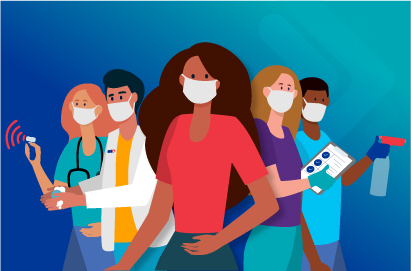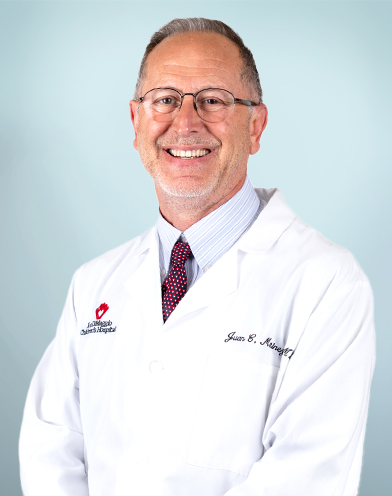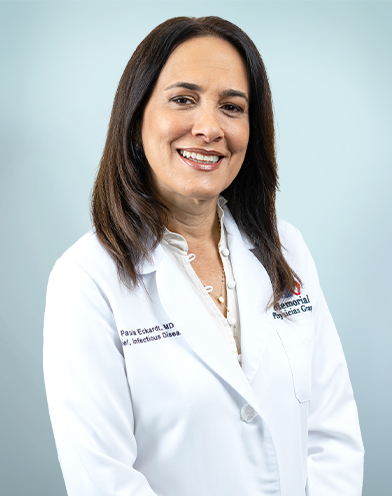Ask the Experts About Safety Precautions
June 30, 2020

With cases of COVID-19 rising in Florida, it is important to remind the community how crucial mask wearing, physical distancing and hand washing is in limiting exposure to the virus.

Chief of Memorial Healthcare System Division of Infectious Disease, Dr. Paula Eckardt, breaks down how people can become exposed to COVID-19, how masks, washing hands and physical distancing can help and some of the terms you may be hearing regularly in reference to the pandemic.

Joe DiMaggio Children’s Hospital pediatric pulmonologist Dr. Juan Martinez also weighs in from a pediatric perspective.
What is exposure?
Dr. Eckardt: The Centers for Disease Control (CDC) states that exposure happens when a person is in contact with someone that
- has COVID-19 for more than 15 minutes,
- is within six feet, and
- is not wearing a mask.
The CDC also states the disease is spread through respiratory droplets produced when an infected person coughs, sneezes or talks. These droplets can land in the mouths or noses of people who are nearby or possibly be inhaled into the lungs.
Some recent studies have suggested that COVID-19 may also be spread by people who are not showing symptoms.
How can we limit exposure to COVID-19 by wearing a mask?
Dr. Eckardt: You can reduce the risk of exposure to COVID-19 by wearing face coverings or mask when outside the home. The bottom line is that masks should be worn every time people go outside and used appropriately by covering the mouth and the nose. The intention of cloth face coverings or face masks is to cover a person’s mouth and nose to prevent the spread of respiratory secretions when they are talking, sneezing, or coughing.
It is also important to note that masks and cloth face coverings should not be placed on:
- children under age 2;
- anyone who has trouble breathing; or
- anyone who is unconscious, incapacitated, or otherwise unable to remove the mask without assistance.
Although, the best method of prevention is to stay home as much as you can.
What if we must leave the house?
Dr. Eckardt: Of course, we all want life to resume to some sense of normalcy and leaving the house is a big part of that.
As the country reopens, it is important to wear your mask and remember that the use of good hand hygiene is vital.
Continue the good habits of washing your hands or using hand sanitizer immediately after touching surfaces or coming back from somewhere like a supermarket. The masks are there not only to protect from the respiratory droplets, they also deter you from touching your face.
Remember to frequently wash your hand or use hand sanitizer before adjusting the face coverings.
The CDC does not recommend changing your clothes or taking a shower when coming home after being in public places, but that is up to you.
I would suggest avoiding unnecessary meetings or large gatherings. Make it a point to stay away from crowded spaces, as physical distancing is a must. The more people you are in contact with, the greater the risk of contracting the virus.
Why should kids wear masks?
Dr. Martinez: Face masks have been proven to be an effective method of preventing or slowing the spread of COVID-19. They limit expulsion of particles that naturally occur while speaking or simply breathing, and this is particularly important in people who have COVID-19, yet are asymptomatic, something that has been seen frequently in younger people and children.
Simple cloth masks, and all masks, also have a secondary benefit of blocking us from touching our faces, one of the ways in which viral infections can be acquired. Therefore, cloth masks may contribute to slowing the spread of infection, especially when combined with physical distancing.
Children should wear masks when exposed to people in public places, and they should wash their hands often.
How does physical distancing help?
Dr. Eckardt: COVID-19 is spread mainly by infected droplets. Droplets are larger particles than can stay up in the air for a long period of time and can land on the floor within six feet. Practicing physical distancing is important for the prevention of this infection.
What’s the difference between asymptomatic vs. symptomatic?
Dr. Eckardt: There is a possibility of severe acute respiratory syndrome coronavirus 2 (SARS-CoV-2) transmission from people who are asymptomatic (have no symptoms) or have not begun to feel the effects of the virus.
Symptomatic patients are more likely to transmit the disease for obvious reasons, as they tend to cough and sneeze frequently.
When should patients get tested?
Dr. Eckardt: You should be tested if you have fever, cough, and shortness of breath, body aches, loss of the sense of smell and/or diarrhea. There are places, like the C.B. Smith Drive-thru testing site offering COVID-19 testing for children and adults.
While we are currently experiencing a surge in positive cases in Florida, it is important to note that we are smarter and more experienced than we were just a few short weeks ago.
Prevention remains the only way to stay healthy and it is important for the community to work together to keep everyone safe and healthy until we find a vaccine. For community members who unfortunately contract the virus and fall ill, our teams at all six hospitals in the Memorial Healthcare System are here to help.
For more information on how Memorial Healthcare System is managing the critical care of patients during COVID-19, visit our safety guidelines.


